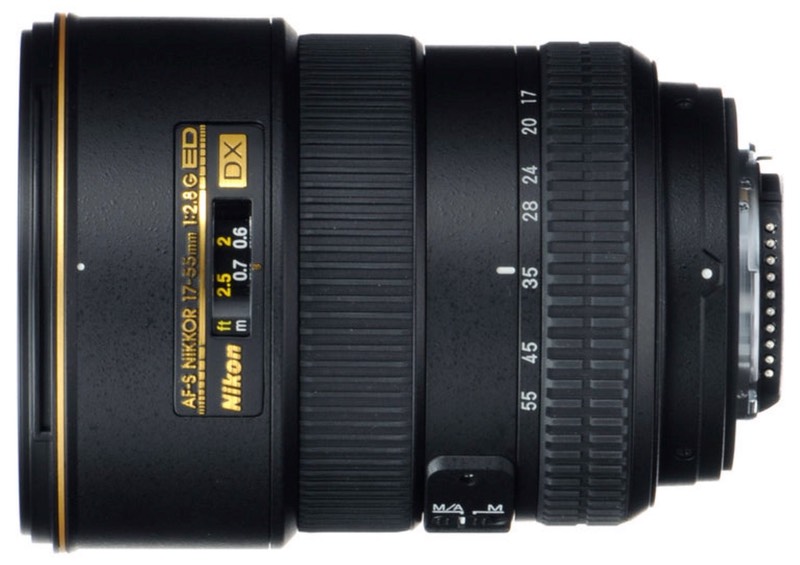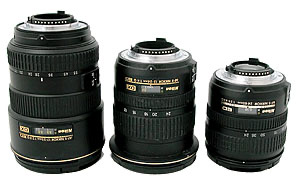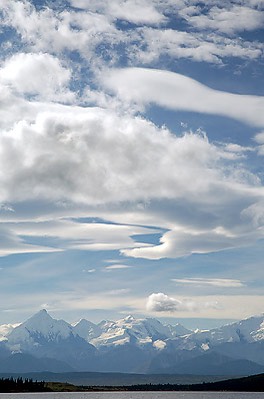This review originally appeared on bythom.com in September 2004. It has been updated and reformatted several times since then, including the most recent changes for the dslrbodies.com site.

What is It?
With the introduction of digital SLRs (DSLRs) in 2009, many photographers lamented the fact that their favorite zooms, such as the 28-70mm , suddenly became less useful, as they lost their wide angle capabilities. With the smaller DX sensor size of the early Nikon digital bodies (D1 series, D100, D2h, Fujifilm S2 Pro), the angle of view for a 17mm focal length was effectively that of a ~26mm lens on a 35mm SLR.
Many professionals regard 28mm at the start of the wide angle range and not overly useful, so they immediately went out and bought the Nikkor 14mm, which at least got them a 21mm equivalent angle of view (the Nikkor 20mm f/2.8 was probably the wide angle most in use by outdoor and nature professionals like myself early in the film SLR era). Still, this really didn't give them any flexibility with wide angle extending into the midrange. The wide-angle zooms helped a bit (17-35mm, 18-35mm, 12-24mm), but they didn't extend into the mid-range and moderate telephoto.
Nikon's solution to the missing lenses was to launch a new series of optics—the DX lenses—which are designed with an image circle more appropriate to the smaller sensor size of the digital lineup. Essentially, these lenses are designed solely for use on Nikon DSLRs (and the Fujifilm DSLRs), though as you'll learn, some can be used in a limited fashion on 35mm bodies.
As I update this article, Nikon has 26 DX lenses (though many of those are duplicate kit and superzooms). But when I first picked up the 17-55mm that's the subject of this review, the only other DX lenses were the D70 "kit lens" (18-70mm), the 10.5mm full frame fisheye, and the 12-24mm f/4 AF-S. Yes, the subject of this review, the 17-55mm f/2.8G DX is an old lens at this point.
The 17-55mm DX lens is a lot larger than you might expect, being only slightly smaller than the old 17-35mm for full frame cameras! That's despite producing a smaller image circle. The minute you pick up this lens, you're going to be curious why it is as large as it is. (Hint: it's all about performance.)

From left to right: the 17-55mm DX, the 12-24mm DX, and the 18-70mm DX (D70 kit lens). This should give you some idea of just how big the 17-55mm really is.
The 17-55mm focal range gives you angle of views from 28 to 79 degrees on a DSLR; it's effectively the same as using an 26-85mm lens on a 35mm body (people keep giving me grief about this, saying that 1.5 x 17 = 25.5. Okay, but in reality it's something more like 1.52 or 1.54 x 17.6 (or something closer to 27). Markings have long been rounded on products. My statement here is effectively correct, if not 100% mathematically accurate.). For some users, that's the stay-on-camera range they have been looking for. Personally, I find myself at the two extreme focal lengths of this lens all the time. Still, there's no denying that this is a popular and much-asked-for focal length range.
This is a two ring design; unlike many recent Nikkors, the zoom ring has once again returned to be nearer the camera than the focus ring. The focus ring itself isn't way out towards the front of the lens, but actually lives at about the halfway mark (i.e., the two rings are in the back half of the lens length).
Focusing goes down to 1.2 feet (0.36m), and the front of the lens has 77mm filter rings.
The lens does have a distance scale, but with no depth of field or infrared markings. You know, even if the lens manufacturers don't want to give us complete depth of field markings, the least they could do is mark the hyperfocal point at one useful focal length and aperture combination. In the case of the DX lenses, this is even more important, as standard 35mm depth of field charts won't help you; you need one designed specifically for the APS-sized sensors (copies of which are in my DSLR books, by the way). On the left side of the lens (from the back of the camera) is one button:
- Manual Focus button: In the M/A position the lens works as usual (autofocus with manual override). In the M position, the lens focuses only manually.
The HB-31 hood supplied with the lens is the bayonet type butterfly style. It can be reversed onto the lens for carrying, but it adds significant diameter to lens when you do so. It's also a bit "deeper" than most of the previous butterfly hoods; it covers the front element well.
You get AF-S focusing with this lens, and that'll take you down to 1 foot and a couple of inches (.36m). The supplied lens cap is the new pinch-front type.
If you want to know the optical formula, it's 14 elements in 10 groups, with 3 aspherical and 3 ED elements. Not extremely complex overall, but with high-quality glass in six of the positions.
Length of the lens is 110mm, and it weighs 26.6 ounces (755g).
The lens comes with the HB-31 lens hood and a soft pouch and sells for US$1499, which makes it Nikon's most expensive DX lens.
Nikon's Web page for the lens.
How's it Handle?
Okay, you'll either love it or hate it.
The zoom ring is quite close to the camera, relatively thin, and stiff. I've run into quite a few photographers who complain about this, though I'm not bothered by any of those things. The "close in" position works well if you're one of those that support the lens with your hand underneath, less well if you're a "side-grabber" with big hands (or use gloves). The bigger issue for me is that it's almost a full quarter turn from one end to the other, which if you're using a finger roll technique works out to three "rolls." But I quickly adjusted to it and stopped noticing after a few minutes of use. If this is the main lens you use, I'd be surprised if you don't adjust, too.
While there isn't a great deal of difference in "feel" of the two rings, the focus ring is a bit wider than the zoom ring, and easy to find if you slide your hand forward (the area past the focus ring widens slightly, so acts as a natural "stop"). The focus ring goes a bit past a quarter turn for focus; unlike the zoom, here I'd actually like just a bit more turn, as once you get out to 5 feet there's not much turn left to get to infinity (and with a mid-range zoom, you're likely to be in this focus range the most often, so you want more than a partial finger roll's worth of fine tuning).
Focal length changes slightly when you're shooting at very close distances (2 feet [.6m] or less). As with most modern lenses, you should be focusing after framing, so I don't see this as a big deal.
While the 17-55mm is a relatively large, heavy lens, it balances very nicely on the front of everything from a D70 to a D2h. With the D70 you'll know it's there, with the D2h you won't. But either way, I felt comfortable.
One side note: this lens is its shortest at 35mm. At wider and longer focal lengths, the inner barrel extends out past the outer barrel. Unlike the 24-120mm and 24-85mm, there is no "wobble" in this extension.
How's it Perform?
Everyone's probably scrolled past all my other comments to get down to this section, so let's cut to the chase: this is a fine lens in almost every respect; but it's not perfect.
Sharpness is strong throughout the range, with f/8 being the point of maximum sharpness on my sample across the entire focal length range. Even at f/2.8 in the corners this lens remains an excellent performer, even on the 24mp bodies.
I'd be comfortable using this lens at f/2.8, but by f/4 there really aren't any big issues left to worry about. I have to magnify my images to 200% and beyond to see the chromatic aberration—it's there, but well controlled. Whereas I often see chromatic aberration effects over several pixels with some of my weaker lenses, on a 6mp D70 I saw one-pixel impacts on edges near the corners, and on the current 20/24mp cameras this now clearly extends out into a range where you want to correct it (and can).
On the image, below, for example, the pixel boundary between the water and shoreline has a very slight one-pixel coloration in the water edge that's more prominent at the two sides (corners). In other words, it's there, but boy is it tough to see short of getting out the magnifier. Of course when you start post processing an image, especially sharpening, sometimes you can replicate those problems further from your edges.
Nothing blows my socks off about the images I've taken with the 17-55mm—Nikon has made a few sharper zooms—but at the same time, nothing immediately strikes me as being a problem, either.
Light falloff is well under control throughout the range on digital bodies. On 35mm bodies, you'll see light fall off at all focal lengths and clear vignetting caused by the small image circle begins at about 26mm. In other words, you could use this lens on a full frame body from about 26-55mm in a pinch.
Here's an image taken at 55mm that shows the modest pincushion distortion (the shore line at the bottom has a bit of curve to it. At the wide end, there's slightly more distortion in the other direction (barrel).

Note that while I'm many miles away from the Alaska Range here (I'm actually sitting in a canoe in the middle of Wonder Lake), the lens is holding quite a bit of detail in the snowy slopes (pretty easy to see even at this small size and the 6mp capture). Indeed, the detail level that's being recorded is lost in the little bit of noise the D70 produces at ISO 200 (i.e., generally I'm camera limited by this lens, not optics limited). If anything, there's a tiny bit of diffraction softness in this image (taken at f/22), but you'd expect that with any lens at that aperture on a digital body. I've taken later photos with the higher megapixel count bodies and gotten much the same impression as I got when I first published this review in 2004.
What looks like light falloff at the top is actually a very gentle 1 stop soft edge graduated neutral density filter.
Distortion performance is good. At both ends there's measurable distortion (barrel at the wide end, pincushion at the telephoto), but it's low in amount and not as obvious as we've seen in some other Nikkor designs. This isn't an architectural lens, but nor is it a fun-house lens, either.
Autofocus is very fast and hunt-free. The f/2.8 aperture helps make low-light focus even better. (This, by the way, is one of two areas in which the decision between the 17-55mm and the 18-70mm DX lens should be made. While the latter is a decent performer and holds its own against the more expensive lens being reviewed here in most respects, you will notice autofocus speed differences as you get into dimmer and dimmer light. The more light that gets to the AF sensors, the better, and that's one of the reasons why you opt for the f/2.8 over the f/3.5-4.5. At 55mm and f/2.8, this lens focuses noticeably more sure than the 18-70mm at 55mm and f/4.5, especially on the D70 and D100, but even on the D2h.)
Flare performance is quite good except for direct into the sun. Unless light is hitting directly on the front element, I've not seen any visible contrast degradation, and the supplied butterfly type hood is excellent in keeping light from hitting the front element in most situations. But if the light source is directly in the picture, things get a little wonkier, and you're likely to see contrast reduction if not ghosting. That's typical of virtually all modern zooms, though.
Bokeh isn't the best of the bunch, but it's actually quite respectable, particularly considering when the lens was designed.
The elephant in the room is the 16-80mm f/2.8-4E. That lens is two-thirds the cost of the one in this review. And it is arguably better in four particulars: (1) it gets you to a true 24mm equivalent at the wide end; (2) it goes to a real telephoto length at the long end (120mm equivalent); it suffers from fewer chromatic aberration issues; and (4) it uses smaller filters. Of course, the 17-55mm also has some pluses over that newer, less expensive lens: (1) the 17-55mm has less linear distortion; and (2) the lens stays at f/2.8 throughout the zoom.
It's tough to recommend the 17-55mm with the 16-80mm on the market given the price differential, which is why my recommended recommendation below has an end point.
Recommended (2009 to 2016)
Some notes for the lens:
- No Converters. The TC-E's don't mount on this lens. Not a big loss, though. Who uses converters on a midrange zoom?
- AF-S Limitations. The in-lens motor that makes this lens focus so swift and sure works only on the D40, D40x, D50, D70, D70s, D80, D100, D200, D1 series, D2 series, Fujifilm S2, S3, and S5. If you have any older body, such as the N60 or Fujifilm S1, AF-S is not operative. Of course, since this is a DX lens, you're only likely to use it on a Nikon DSLR, but it can be used on film and fullframe Nikon DSLRs if you're willing to accept imaging circle limitations.
- G Limitations. Because the lens has no aperture ring, if you were to use it on an older 35mm body such as the F4 or N90s, you'd need to put those cameras into Program or Shutter-priority exposure modes. Again, since this is a DX lens, that's not likely, but the lens does cover the full frame from 26-55mm, it's possible to use it on these cameras.
